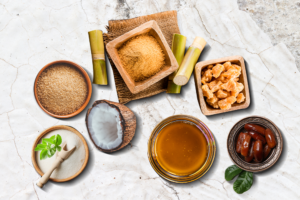Imagine eating Idlis or vadas without fresh coconut chutney. Or Samosas or Bhelpuri without the mint and tamarind chutneys. Most Indians can’t imagine a day without these delicious condiments featuring in at least one of their meals – be it with breakfast or snacks, at home or on the streets. And it’s not just us desis who have succumbed to this love but also the videshis who have, in fact, developed numerous variations of our popular chutneys.
Chutneys are integral to all Indian cuisines and come in a variety of options to suit different preparations and times of the day. They are typically made from a paste of uncooked vegetables or fruit (such as mint, tamarind, and mangoes), green chillies, green herbs and spices, an acid-base such as vinegar, lime or tamarind juice, and sometimes sugar. Indian chutneys are freshly prepared and are meant to be consumed shortly after. Needless to say, the freshness and finesse of chutneys play a crucial role in delivering memorable snacking and street food experiences.
Did you know that chutneys go back a long, long way?
Chutneys, in its truest sense, originated on the Indian subcontinent over 2,000 years ago as a sauce or paste made from fresh ingredients; possibly as a way to make use of surplus seasonal produce before they went stale. Food historian KT Achaya is of the opinion that some of the earliest indications of the use of chutney can be traced back to the Indus valley civilisation, where several hand grinders were uncovered during excavations. Eventually, the concept spread to other parts of the world through trade including the ancient Roman civilisation, which used it for the preservation of food. This soon spread to the rest of Europe. The concept of using greens and a souring agent like vinegar or lime like our traditional mint chutney became a popular concept in Medieval Europe and they tried it with many other types of greens. But it eventually died out there. In the modern age, closer to the 20th century, the interest was revived by the British who took this concept overseas from India. From there, it was a hop, skip and jump to the modern version found in stores today.
Driven by the need for convenience and preference towards traditional ingredients and recipes among modern consumers, chutneys have fast emerged as a popular item on retail shelves in India. While they add an extra zing to any and almost all snacks, preparing it is a tedious task, and hence the mounting popularity of packaged chutneys. Attracting interest from large and established as well as new age brands alike, say Dabur Hommade, Mother’s Recipes, Spice Story, ITC Kitchens of India, and Veeba, to name a few – we expect chutneys as a category to witness a notable number of new entrants and launches in the months to come.
Need for convenience
Chutney has remained a staple in our diets over the years. However, due to our fast-paced lifestyles, the tradition of making them is gradually fading. Even in the food industry, chutney-making has become difficult and time-consuming for chefs, particularly due to shrinking kitchen spaces and a lack of skilled manpower. Furthermore, due to their short shelf life, restaurants often end up making a single variety of chutneys for use across all dishes. This compromises the overall dining experience to a certain extent. This is where the convenience of packaged/branded chutneys, offered by culinary solution companies, comes into play.
Imagine eating Idlis or vadas without fresh coconut chutney. Or Samosas or Bhelpuri without the mint and tamarind chutneys. Most Indians can’t imagine a day without having these delicious condiments in at least one of their meals – breakfast or snacks, at home or on the streets. And it’s not just us desis who have succumbed to this love but also the videshis who have developed numerous variations of our popular chutneys.
Chutneys are integral to all Indian cuisines and come in various options to suit different preparations and times of the day. They are typically made from a paste of uncooked vegetables or fruit (such as mint, tamarind, and mangoes), green chillies, green herbs and spices, an acid-base such as vinegar, lime or tamarind juice, and sometimes sugar. Indian chutneys are freshly prepared and are meant to be consumed shortly after. The freshness and finesse of chutneys play a crucial role in delivering memorable snacking and street food experiences.
Did you know that chutneys go back a long, long way?
In their truest sense, chutneys originated on the Indian subcontinent over 2,000 years ago as a sauce or paste made from fresh ingredients, possibly as a way to use surplus seasonal produce before they went stale. Food historian KT Achaya believes that some of the earliest indications of the use of chutney can be traced back to the Indus valley civilisation, where several hand grinders were uncovered during excavations. Eventually, the concept spread to other parts of the world through trade, including the ancient Roman civilisation, which used it to preserve food. This soon spread to the rest of Europe. Using greens and a souring agent like vinegar or lime like our traditional mint chutney became a popular concept in Medieval Europe, and they tried it with many other types of greens. But it eventually died out there. In the modern age, closer to the 20th century, the interest was revived by the British, who took this concept overseas from India. From there, it was a hop, skip and jump to the modern version found in stores today.
Driven by the need for convenience and preference towards traditional ingredients and recipes among modern consumers, chutneys have fast emerged as a popular item on retail shelves in India. While they add an extra zing to any and almost all snacks, preparing them is a tedious task, hence the mounting popularity of packaged chutneys. Attracting interest from large and established as well as new age brands alike, say Dabur Hommade, Mother’s Recipes, Spice Story, ITC Kitchens of India, and Veeba, to name a few – we expect chutneys as a category to witness a significant number of new entrants and launches in the months to come.
Need for convenience
Chutney has remained a staple in our diets over the years. However, the tradition of making them is gradually fading due to our fast-paced lifestyles. Even in the food industry, chutney-making has become difficult and time-consuming for chefs due to shrinking kitchen spaces and a lack of skilled resources. Furthermore, due to their short shelf life, restaurants often make a single type of chutney for use across all dishes. This compromises the overall dining experience to a certain extent. This is where the convenience of packaged/branded chutneys offered by culinary solution companies comes into play.
Packaged chutneys are consistent in taste and deliver a longer shelf life. Also, with modern processing and packaging technologies, it is possible to offer them with minimal to zero preservatives and other additives. Convinced by the ease of use and savings on the cost and efforts, contemporary chefs are happy to switch to packaged chutneys, giving them more flexibility to experiment with their master creations.

What’s popular in chutneys today?
In India, there are countless chutney varieties. Every state has a plethora of recipes for various seasons. However, a few are popular throughout the country and can be found as an accompaniment to the main course in almost every restaurant. They are also highly versatile in application. Here’s a brief glimpse at the most popular among these chutneys.
Coconut chutney: Freshly ground coconut chutney is a staple in south India with most breakfast items and one of the most popular chutneys worldwide wherever Indian food is enjoyed. The sweet creaminess of raw grated coconut paired with the heat of mustard, green chillies, and ginger makes this an evergreen winner. It is most popularly paired with dosa, idli, vada and appams.
Mint chutney: Mint chutney is not only a popular accompaniment to fried snacks and chaat, but it is also sometimes used to flavour the snacks. The zesty flavour of mint acts as a palate cleanser to greasy food. It was initially made in households to specifically consume mint in raw form since it has anti-inflammatory and antiseptic properties that help your stomach process food and stay healthy. Made by grinding or hand-pounding raw mint with ginger, garlic and green chillies, this chutney is versatile in applications and a household staple across many states of India and medieval Europe.
Date and tamarind chutney: This yummy chutney is loved for its sweetness, tanginess and sourness. It is associated with many street foods such as pattice, vadas, samosa, puris, bhel etc. and can be made using dates, tamarind, sugar, coriander seeds, sugar and salts.
Chilli garlic chutney: The chilli garlic chutney is packed with intense flavours and a popular means to introduce additional spice to the palate. It’s also a tasty way to introduce raw garlic into our daily menu for its health benefits, from lowering cholesterol and blood sugar to improving immunity and digestion. It’s also a staple in street foods, right from vada pavs to chaat like bhel, Sev, puris, etc. In poorer households in arid regions of India, meals were often limited to local bread like bajri roti or bhakri with raw onions and chilli garlic chutney, both for taste and nutritional benefits.
Spicy Tomato Chutney: This spicy tomato chutney is a warm cooked chutney that is used with a wide range of breakfasts like dosa, idli, thepla etc. It is also eaten along with rice or roti. It is spicy yet tangy and is bound to make you want more. Since it is prevalent in many states, many households have different takes on the recipe, but most versions contain tomatoes, garlic, cumin, chillies, oil and salt.
Sweet Tomato Chutney: This sweet tomato chutney originates from Bengal and brings out the flavour and aromas of panch phoran, or ‘five spices’ from Bengal. Interestingly, this chutney also uses raisins as a sweetener. To make this sweet and savoury chutney, you need tomatoes, mustard seeds, fennel seeds, cumin seeds, nigella seeds and fenugreek seeds.
Peanut Chutney: Peanut chutney is a classic dip used for idlis, vadas and dosas. This a popular staple in Andhra households, with generous use of roasted peanuts, dry red chillies, garlic, onion, mustard seeds, curry leaves, urad dal, oil and salt.
Mango Chunda: Aam or Mango Chunda is an easy-to-prepare Gujarati chutney that is a perfect balance of sweet, spicy and sour that enhances the flavours of the dishes it is paired with. It’s more a relish than a chutney, cooked or sundried and made of raw mangoes, sugar or jaggery, salt, red chilli powder and cumin powder. Aam chunda is popularly paired with theplas, but chunda is versatile and even works beautifully with something as simple as toast. Or as a sweetish dip for crudites and chips when mixed with other ingredients like mayonnaise.
Thecha: Thecha receives a special mention here. A quintessential condiment in Maharashtrian meals, thecha is a chunky and semi-dry hand-pounded chutney made with roasted green chillies, garlic and roasted peanuts. Its most famous pairing is jowar bhakri and pitla (thick, mild sauce made with gram flour and herbs) with sliced onions on the side. Unlike most hand-pounded chutneys, which are now blitzed in the blender, the thecha is exclusively still made in an old-fashioned mortar and pestle.
Similar chutneys based on roasted green chillies can also be founded in northeastern states like Mizoram and Nagaland. For example, a popular green chilli chutney in Mizoram is the Hmarcha Rawt – a pungent chutney made with roasted chillies, chopped onion and ginger, which is then eaten with fermented soybean paste and rice.
Symega and certain other companies today offer quite a few traditional chutneys and a few modern global ones for QSR & HoReCas. Fusion condiments like Tandoori Mayonnaise, pizza pasta sauce, smoky barbeque sauce, schezwan sauce and hot garlic sauce are popular choices among chefs and restaurateurs looking for quick flavour solutions in their kitchens. In addition, the wide range of dips, spreads & dressings, marinades, oriental sauces, culinary sauces, and different flavours of mayonnaise offered by these companies come in handy for chefs looking for consistency in taste as well as economy of scale.
New age brands in India rediscovering chutneys
Many Indian FMCG brands, such as Ching’s Secret, Dabur Homemade, Spice Story, Bun Maska, Jus Amazing, and others, are rediscovering chutneys and attempting to bottle and market the chutney tradition. They address not just the end users’ issues but also tie up with HoReCas looking for a hassle-free method of including chutneys in their menu. Many artisanal brands are also marketing fermented and sun-dried condiments, which are organic and naturally cured with minimal processing to retain nutrients.
Dabur Hommade, in addition to traditional cooking pastes like ginger & garlic and tamarind, also markets the sweet kalonji tomato chutney that is popular in West Bengal and a Rajasthani Chilli Garlic chutney. Products of new-age brands like Veeba and Spice Story are crafted explicitly to augment popular fast foods. Veeba, for instance, started as an institutional supplier, plying QSR outfits with sauces popularly used in street food and fast food joints, like flavoured mayonnaises, oriental sauces and pasta sauces. They later expanded to HoReCas and retail, specialising in vegetarian, cholesterol free and low-fat dressings. They offer mayonnaises made with olive oil to capitalise on the health-consciousness trend.
Spice Story, on the other hand, has played on the nostalgia value of popular chutney pairings like Bombay sandwich chutney, Dilliwali spicy mint chutney, and Kolkata spicy mango chutney, among others. The use of regional names in products also aligns with recent consumer interest in hyper-local products. Spice Story offers a unique range of hot sauces crafted to target Indians’ love for chilli-based condiments. Their most popular offering Kolhapuri Jharia is made with regional chillies and marketed not just as a dip or a side dish but as a sauce used in cooking. All the chutneys and sauces are vegan and gluten-free with no fat.
Jus Amazin also caters to health-conscious consumers with a 5-minute pasta Alfredo sauce made of nuts, making it vegan, gluten-free, and keto-friendly. Not all brands are just about health consciousness, though. For example, Bun Maska markets pure indulgence through their ethically sourced flavoured butters. Their hot sauces deserve a special mention because they offer a range of hot truffle sauces aimed at the modern Indian palate, including an extra spicy one.
Chutneys and sauces remain prime favourites for Indians, and more brands are making forays into this sector today.
Symega offers a range of culinary solutions, including chutneys, sauces & mayonnaises, that help chefs save time and cost without compromising on their passion for creation. Our state-of-the-art R&D centre, led by highly qualified chefs and food technologists, is a one-stop shop for retail brands and chefs looking to materialise their new ideas. From product development, manufacturing, onsite tests & trials, distribution & marketing, Symega is with you at every step. So if you’ve got an idea for a new chutney/sauce, partner with Symega for co-development and co-manufacturing solutions.
To know more about Symega’s chutneys, sauces, and manufacturing capabilities, write to us at marketing@symega.com




